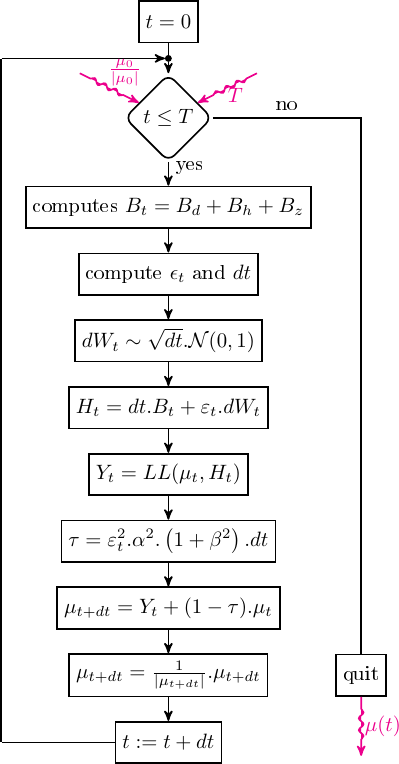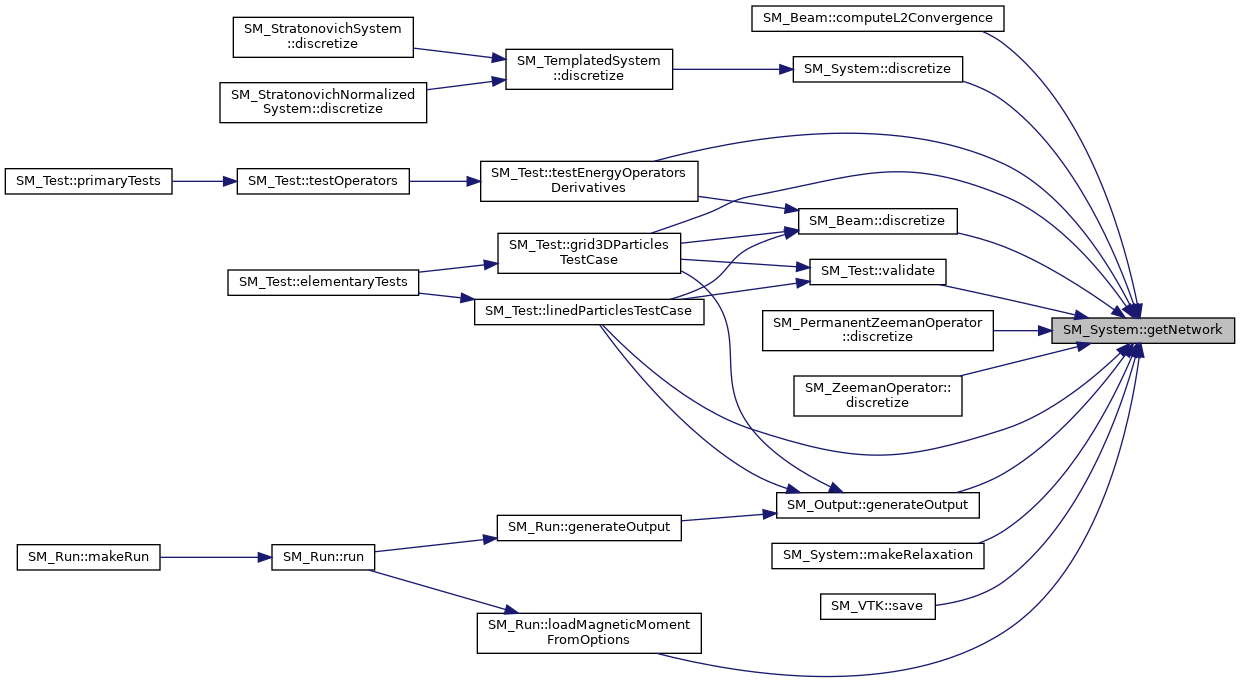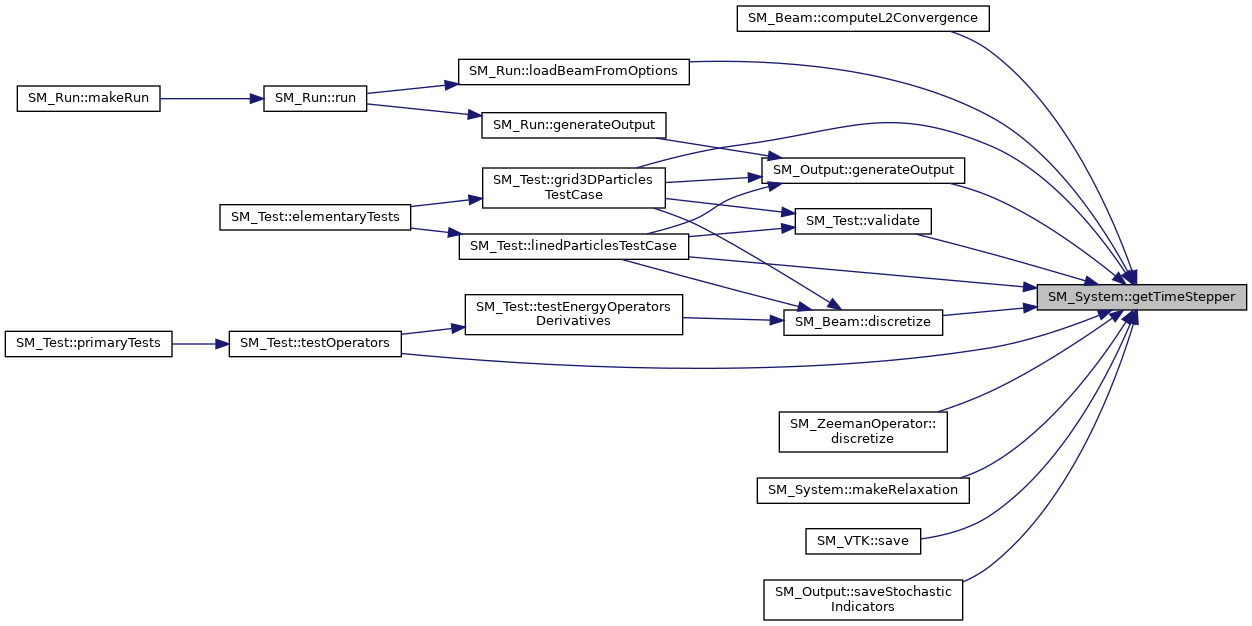This class is a simulation of one trajectory class for Stoch Microm package. More...
#include <SM_System.h>


Public Member Functions | |
| virtual tMemSize | getMemorySize () const |
| return the memory size of the class and the memory size of all its attributes/associations More... | |
| virtual tMemSize | getContentsMemorySize () const |
| return the memory size of the included associations More... | |
| const SM_Network & | getNetwork () const |
| get the network More... | |
| SM_Network & | getNetwork () |
| get the network More... | |
| const SM_TimeStepper & | getTimeStepper () const |
| get the time stepper More... | |
| SM_TimeStepper & | getTimeStepper () |
| get the time stepper More... | |
| void | setInitialMagneticMoment (const std::valarray< tReal > &mu0) |
| set the initial Magnetic Moment by moving More... | |
| void | setInitialMagneticMoment (const SM_RealField &mu0) |
| set the initial Magnetic Moment by moving More... | |
| void | setInitialMagneticMoment (const tIndex &N, const std::array< tReal, 3 > &mu0) |
| set the initial Magnetic Moment by copy More... | |
| const SM_RealField & | getInitialMagneticMoment () const |
| set the initial Magnetic Moment More... | |
| void | setNoiseRateFunction (CORE_UniquePointer< SM_NoiseRateFunction > &f) |
| gst the noise rate function More... | |
| SM_NoiseRateFunction & | getNoiseRateFunction () |
| get the noise rate function More... | |
| const SM_NoiseRateFunction & | getNoiseRateFunction () const |
| get the noise rate function More... | |
| const SM_LandauLifschitzFunction & | getLandauLifschitzFunction () const |
| get the Landau Lifschitz function return the Landau lifschitz function for reading More... | |
| SM_LandauLifschitzFunction & | getLandauLifschitzFunction () |
| get the Landau Lifschitz function More... | |
| void | addOperator (CORE_UniquePointer< SM_Operator > op) |
| add operator More... | |
| const SM_Operator * | getOperator (const tString &name) const |
| get the operator with name More... | |
| void | copyOperators (const SM_System &system) |
| copy the operator More... | |
| const std::map< tString, CORE_UniquePointer< SM_Operator > > & | getOperators () const |
| get the operators More... | |
| tIndex | getOperatorsNumber () const |
| get the operator with name More... | |
| virtual void | getOperatorNames (std::vector< tString > &names) const |
| get the operator names More... | |
| virtual void | discretize () |
| discretize the system More... | |
| tBoolean | makeRelaxation (const SM_StochasticFunction *randomFunction, tReal *mu, tReal *Es) |
| compute the relaxation process by calling only virtual methods More... | |
| virtual tString | toString () const override |
| turn the class into a string representation More... | |
| template<class T > | |
| std::shared_ptr< T > | getSharedPointer () |
| return the shared pointer for this More... | |
| template<class T > | |
| std::shared_ptr< const T > | getConstSharedPointer () const |
| return a const shared pointer for this More... | |
| template<class T > | |
| tBoolean | isInstanceOf () const |
| test if the clas T is an instance of this class More... | |
| tString | getClassName () const |
| return the name of the class More... | |
| tString | getPointerString () const |
| retrun the pointer of the class as a string More... | |
| tString | getIdentityString () const |
| retrun the string identification of the class More... | |
Static Public Member Functions | |
| static tBoolean | EnableMemoryStack (const tBoolean &isMemoryChecked) |
| enable the memory stack More... | |
| static void | EnableMemoryStack () |
| enable the memory stack More... | |
| static void | DisableMemoryStack () |
| disable the memory stack More... | |
| static tBoolean | IsMemoryStackEnabled () |
| return trur if the memory stack is enabled More... | |
| static tString | MemoryStackToString () |
| get the memory stack in string More... | |
| static tIndex | GetRegisteredClassesNumber () |
| get the memory stack in string More... | |
Protected Member Functions | |
| SM_System (void) | |
| create a class More... | |
| virtual | ~SM_System (void) |
| destroy the class More... | |
| SM_RealField & | getMagneticField () |
| get the magnetic field More... | |
| void | computeMagneticField (const tIndex &t, const SM_Network &network, const tReal *mu, tReal *B) const |
| compute the magnetic field at time step index t by calling the virtual method SM_Operator::computeMagneticField() More... | |
| void | computeMagneticFieldAndEnergies (const tIndex &t, const SM_Network &network, const tReal *mu, tReal *B, tReal *Es) const |
| compute the magnetic field by calling the virtual method SM_Operator::computeMagneticField() More... | |
| virtual tBoolean | computeMuAtNextTimeStep (const tReal &dt, const tReal &epsilon_t, const tIndex &nParticles, const tDimension &dim, const tReal *mu_t, tReal *mu_tpdt) const =0 |
| compute mu at time step More... | |
Private Member Functions | |
| template<class T > | |
| std::shared_ptr< T > | setThis (std::unique_ptr< T, CORE_Object::Delete > &up) |
| set the shared pointer from an unique pointer More... | |
Private Attributes | |
| SM_LandauLifschitzFunction | mLLFunction |
| SM_Network | mNetwork |
| SM_TimeStepper | mTimeStepper |
| std::map< tString, CORE_UniquePointer< SM_Operator > > | mOperators |
| SM_RealField | mB |
| SM_RealField | mMu0 |
| CORE_UniquePointer< SM_NoiseRateFunction > | mNoiseRateFunction |
| std::weak_ptr< CORE_Object > | mThis |
Detailed Description
This class is a simulation of one trajectory class for Stoch Microm package.
This class solves the system
- \( \displaystyle dY_t=\alpha. A(\mu_t) B.dt + \epsilon \alpha A(\mu_t)dW_t - \delta . \varepsilon^2.\alpha^2.\left( 1+\beta^2\right).dt.\mu_t \)
- \( \mu_t=\displaystyle \frac{Y_t}{|Y_t|} \)
- \( dW_t \sim \sqrt{dt} \mathcal{N}(0,1) \)
Where \( \delta \) is 0 for Ito System and 1 for Stratonovich normalized system For the Stratonovich system the Matrix A is computed with the assumption that \( |\mu_t|=1 \) so that the we have directly \( \mu_t= Y_t \).
The general stochastic relaxation process implemented in the class SM_StratonovichNormalizedSystem can be sumarized with the following algorithm

- for the Ito system \( \tau \) is set to 1 implemented in the class SM_ItoSystem
for the stratonovich system the normalization of \( \mu_{t+dt} \) is ignored and the normalized formulation of the Landau Lifschitz equation is used (see SM_LandauLifschitzFunction). It is implemented in the class SM_StratonovichSystem .
- Version
- 2.0
- Version
- 2.0
Constructor & Destructor Documentation
◆ SM_System()
|
inlineprotected |
create a class
References mLLFunction, mMu0, SM_LandauLifschitzFunction::setAlpha(), SM_LandauLifschitzFunction::setBeta(), and tReal.

◆ ~SM_System()
|
inlineprotectedvirtual |
destroy the class
Member Function Documentation
◆ addOperator()
|
inline |
add operator
- Parameters
-
[in,out] op : operator to add. op points to null at the output
References mOperators.
Referenced by SM_Test::grid3DParticlesTestCase(), SM_Test::linedParticlesTestCase(), SM_Run::loadOperatorsFromOptions(), and SM_Test::testOperators().

◆ computeMagneticField()
|
inlineprotected |
compute the magnetic field at time step index t by calling the virtual method SM_Operator::computeMagneticField()
- Parameters
-
[in] t index of the time step [in] network : network of the field [in] mu magnetic moments of size nParticles x dim [out] B magnetic field of size nParticles x dim
References SM_Network::getDimension(), SM_Network::getParticlesNumber(), mOperators, tIndex, and tReal.

◆ computeMagneticFieldAndEnergies()
|
inlineprotected |
compute the magnetic field by calling the virtual method SM_Operator::computeMagneticField()
- Parameters
-
[in] t index of the time step [in] network : network of the field [in] mu magnetic moments of size nParticles x dim [out] B magnetic field of size nParticles x dim [out] Es Energies of size nOpertaors+1
References SM_Network::getDimension(), SM_Network::getParticlesNumber(), mOperators, tIndex, and tReal.
Referenced by makeRelaxation().


◆ computeMuAtNextTimeStep()
|
protectedpure virtual |
compute mu at time step
- Parameters
-
[in] dt time step [in] epsilon_t : epsilon at time t [in] nParticles number of particles [in] dim dimension of space [in] mu_t : mu at time t [in,out] mu_tpdt mu at time t+dt
\( \mu_{t+dt}=\mu_{t+dt}+(1-K.\varepsilon_t^2.dt).\mu_t \)
- Returns
- false if there is a point \( P_i \) where at the coordinate k , \( |\mu_k(P_i)| \) is too much greater than 1 (10 for instance)
Implemented in SM_TemplatedSystem< SystemImpl >, SM_TemplatedSystem< SM_ItoSystem >, SM_TemplatedSystem< SM_StratonovichSystem >, and SM_TemplatedSystem< SM_StratonovichNormalizedSystem >.
Referenced by makeRelaxation().

◆ copyOperators()
|
inline |
copy the operator
- Parameters
-
[in] system : the operators of the system are copied.
References getOperators().

◆ DisableMemoryStack()
|
inlinestaticinherited |
disable the memory stack
Referenced by CORE_Object::EnableMemoryStack().

◆ discretize()
|
inlinevirtual |
discretize the system
- Parameters
-
[in] nTimeSteps number of time steps [in] nParticles number of particles
Reimplemented in SM_StratonovichSystem, SM_StratonovichNormalizedSystem, SM_TemplatedSystem< SystemImpl >, SM_TemplatedSystem< SM_ItoSystem >, SM_TemplatedSystem< SM_StratonovichSystem >, and SM_TemplatedSystem< SM_StratonovichNormalizedSystem >.
References getNetwork(), SM_Network::getParticlesNumber(), mB, mOperators, and CORE_Field< T, K, D, S, I >::setElementsNumber().
Referenced by SM_TemplatedSystem< SystemImpl >::discretize().


◆ EnableMemoryStack() [1/2]
|
inlinestaticinherited |
enable the memory stack
Referenced by CORE_Object::EnableMemoryStack(), and CORE_Run::SetDebugOptions().

◆ EnableMemoryStack() [2/2]
|
inlinestaticinherited |
enable the memory stack
- Parameters
-
[in] isMemoryChecked : true to verify memory allocation of CORE_Object classes
- Returns
- true if the memroy is checked
References CORE_Object::DisableMemoryStack(), CORE_Object::EnableMemoryStack(), and CORE_Object::IsMemoryStackEnabled().

◆ getClassName()
|
inlineinherited |
return the name of the class
- Returns
- the string name of the class
Referenced by CORE_Object::getIdentityString(), and CORE_Test::testTypes().

◆ getConstSharedPointer()
|
inlineinherited |
return a const shared pointer for this
- Returns
- the shared pointer as a type T
References CORE_Object::mThis.
◆ getContentsMemorySize()
|
inlinevirtual |
return the memory size of the included associations
- Returns
- the memory size of the storage in bytes 1 Kb = 1024 bytes 1 Mb = 1024 Kb 1 Gb = 1024 Mb 1 Tb = 1024 Gb 1 Hb = 1024 Tb
Reimplemented from CORE_Object.
References CORE_Object::getContentsMemorySize(), SM_Network::getContentsMemorySize(), CORE_Field< T, K, D, S, I >::getContentsMemorySize(), mB, mLLFunction, mMu0, mNetwork, mNoiseRateFunction, mOperators, and tMemSize.
Referenced by SM_ItoSystem::getMemorySize(), SM_StratonovichNormalizedSystem::getMemorySize(), SM_StratonovichSystem::getMemorySize(), getMemorySize(), and SM_TemplatedSystem< SystemImpl >::getMemorySize().


◆ getIdentityString()
|
inlineinherited |
retrun the string identification of the class
- Returns
- the string identity of the class
References CORE_Object::getClassName(), and core_functions::pointerToString().
Referenced by CORE_Test::testArray(), CORE_Test::testField(), CORE_Test::testTypes(), CORE_Object::toString(), CORE_ClassFactory::toString(), and CORE_Field< T, K, D, S, I >::toString().


◆ getInitialMagneticMoment()
|
inline |
set the initial Magnetic Moment
- Returns
- the initial magnetic moment
References mMu0.
Referenced by SM_Beam::discretize(), SM_DemagnetizedOperator::discretize(), and makeRelaxation().

◆ getLandauLifschitzFunction() [1/2]
|
inline |
get the Landau Lifschitz function
- Returns
- the Landau lifschitz function for writing
References mLLFunction.
◆ getLandauLifschitzFunction() [2/2]
|
inline |
get the Landau Lifschitz function return the Landau lifschitz function for reading
References mLLFunction.
Referenced by SM_Beam::discretize(), SM_StratonovichNormalizedSystem::discretize(), SM_StratonovichSystem::discretize(), SM_Test::grid3DParticlesTestCase(), SM_Test::linedParticlesTestCase(), SM_Run::loadBeamFromOptions(), makeRelaxation(), and SM_Test::testOperators().

◆ getMagneticField()
|
inlineprotected |
get the magnetic field
References mB.
◆ getMemorySize()
|
inlinevirtual |
return the memory size of the class and the memory size of all its attributes/associations
- Returns
- the memory size of the class and the memory size of its attributes/associations in bytes The mamory size is :
- the added size of the base classes which contains:
- the primary attributes size depends on the order: (first delare the smallest attributes size
- all virtual functions costs <pointer-size> (4 32xor 8 64x) bytes by virtual function
- virtual inherihtance will increase of (4 or 8) bytes
- we add the size of the contains values of the attributes : for example the size of a string is the length of the string 1 octet = 1 byte 1 Ko = 1024 bytes 1 Mo = 1024 Ko 1 Go = 1024 Mo
- the added size of the base classes which contains:
Reimplemented from SM_Object.
Reimplemented in SM_TemplatedSystem< SystemImpl >, SM_TemplatedSystem< SM_ItoSystem >, SM_TemplatedSystem< SM_StratonovichSystem >, SM_TemplatedSystem< SM_StratonovichNormalizedSystem >, SM_StratonovichSystem, SM_StratonovichNormalizedSystem, and SM_ItoSystem.
References getContentsMemorySize().

◆ getNetwork() [1/2]
|
inline |
◆ getNetwork() [2/2]
|
inline |
get the network
- Returns
- the network for reading
References mNetwork.
Referenced by SM_Beam::computeL2Convergence(), SM_Beam::discretize(), discretize(), SM_PermanentZeemanOperator::discretize(), SM_ZeemanOperator::discretize(), SM_Output::generateOutput(), SM_Test::grid3DParticlesTestCase(), SM_Test::linedParticlesTestCase(), SM_Run::loadMagneticMomentFromOptions(), makeRelaxation(), SM_VTK::save(), SM_Test::testEnergyOperatorsDerivatives(), and SM_Test::validate().

◆ getNoiseRateFunction() [1/2]
|
inline |
get the noise rate function
- Returns
- the noise rate function
References mNoiseRateFunction.
Referenced by SM_Beam::computeL2Convergence(), makeRelaxation(), SM_Output::saveStochasticIndicators(), and SM_Beam::templatedSimulate().

◆ getNoiseRateFunction() [2/2]
|
inline |
◆ getOperator()
|
inline |
get the operator with name
- Parameters
-
[in] name : name of the operator
References mOperators.
Referenced by SM_Beam::computeL2Convergence(), SM_TemplatedSystem< SystemImpl >::discretize(), and SM_Test::testEnergyOperatorsDerivatives().

◆ getOperatorNames()
|
inlinevirtual |
get the operator names
- Parameters
-
[out] names : names of the operator
Reimplemented in SM_TemplatedSystem< SystemImpl >, SM_TemplatedSystem< SM_ItoSystem >, SM_TemplatedSystem< SM_StratonovichSystem >, and SM_TemplatedSystem< SM_StratonovichNormalizedSystem >.
References mOperators.
Referenced by SM_Output::generateOutput().

◆ getOperators()
|
inline |
get the operators
- Returns
- the operators map : name->operator
References mOperators.
Referenced by copyOperators().

◆ getOperatorsNumber()
|
inline |
get the operator with name
- Parameters
-
[in] name : name of the operator
References mOperators.
Referenced by SM_Beam::discretize(), makeRelaxation(), and SM_Output::saveStochasticIndicators().

◆ getPointerString()
|
inlineinherited |
retrun the pointer of the class as a string
- Returns
- the pointer of the calss as a string
References core_functions::pointerToString().

◆ GetRegisteredClassesNumber()
|
inlinestaticinherited |
get the memory stack in string
- Returns
- the string representation of the memory stack
◆ getSharedPointer()
|
inlineinherited |
return the shared pointer for this
- Returns
- the shared pointer as a type T
References CORE_Object::mThis.
◆ getTimeStepper() [1/2]
|
inline |
◆ getTimeStepper() [2/2]
|
inline |
get the time stepper
- Returns
- the time stepper for reading
References mTimeStepper.
Referenced by SM_Beam::computeL2Convergence(), SM_Beam::discretize(), SM_ZeemanOperator::discretize(), SM_Output::generateOutput(), SM_Test::grid3DParticlesTestCase(), SM_Test::linedParticlesTestCase(), SM_Run::loadBeamFromOptions(), makeRelaxation(), SM_VTK::save(), SM_Output::saveStochasticIndicators(), SM_Test::testOperators(), and SM_Test::validate().

◆ isInstanceOf()
|
inlineinherited |
test if the clas T is an instance of this class
- Returns
- true if the object is an instance of T
Referenced by SM_Beam::templatedSimulate().

◆ IsMemoryStackEnabled()
|
inlinestaticinherited |
return trur if the memory stack is enabled
Referenced by CORE_Object::EnableMemoryStack(), and main().

◆ makeRelaxation()
| tBoolean SM_System::makeRelaxation | ( | const SM_StochasticFunction * | randomFunction, |
| tReal * | mu, | ||
| tReal * | Es | ||
| ) |
compute the relaxation process by calling only virtual methods
- Parameters
-
[in] randomFunction random function for the stochastic simulation [out] mu mu at all time of size nParticules x dim x nTimeSteps [out] Es energies of the system for each operatr & total operator
References ASSERT_IN, SM_LandauLifschitzFunction::computeFunction(), SM_NoiseRateFunction::computeFunction(), computeMagneticFieldAndEnergies(), computeMuAtNextTimeStep(), CORE_Field< T, K, D, S, I >::getDimension(), SM_Network::getDimension(), CORE_Field< T, K, D, S, I >::getElementsNumber(), getInitialMagneticMoment(), getLandauLifschitzFunction(), SM_TimeStepper::getMaximumTimeStepsNumber(), getNetwork(), getNoiseRateFunction(), getOperatorsNumber(), SM_Network::getParticlesNumber(), SM_TimeStepper::getTimeStep(), getTimeStepper(), mB, mMu0, SM_StochasticFunction::random(), tBoolean, tIndex, and tReal.

◆ MemoryStackToString()
|
inlinestaticinherited |
get the memory stack in string
- Returns
- the string representation of the memory stack
Referenced by main().

◆ setInitialMagneticMoment() [1/3]
|
inline |
set the initial Magnetic Moment by moving
- Parameters
-
[in] mu0 constant value of Mu at time 0 by moving
References mMu0, and CORE_StdPtrField< T, K, D >::normalize().

◆ setInitialMagneticMoment() [2/3]
|
inline |
set the initial Magnetic Moment by moving
- Parameters
-
[in] mu0 constant value of Mu at time 0 by moving
References mMu0, and CORE_StdPtrField< T, K, D >::normalize().
Referenced by SM_Test::grid3DParticlesTestCase(), SM_Test::linedParticlesTestCase(), SM_Run::loadMagneticMomentFromOptions(), and SM_Test::testEnergyOperatorsDerivatives().


◆ setInitialMagneticMoment() [3/3]
|
inline |
set the initial Magnetic Moment by copy
- Parameters
-
[in] N : number of particles [in] mu0 constant value of Mu
References CORE_StdPtrField< T, K, D >::initialize(), mMu0, and CORE_Field< T, K, D, S, I >::setElementsNumber().

◆ setNoiseRateFunction()
|
inline |
gst the noise rate function
- Parameters
-
[in] f : the noise rate function
References mNoiseRateFunction.
Referenced by SM_Test::grid3DParticlesTestCase(), SM_Test::linedParticlesTestCase(), SM_Run::loadBeamFromOptions(), and SM_Test::testOperators().

◆ setThis()
|
inlineprivateinherited |
set the shared pointer from an unique pointer
- Parameters
-
[in,out] up unique pointer of the class at input, points to null pointer at output
- Returns
- the shared pointer of the class
Method only calledby the friend class CORE_ClassFactory::NewSharedInstance()
References CORE_Object::mThis.
◆ toString()
|
overridevirtual |
turn the class into a string representation
- Returns
- a string representation of the class
Reimplemented from CORE_Object.
References SM_Network::getDimension(), CORE_Field< T, K, D, S, I >::getElementsNumber(), mLLFunction, mMu0, mNetwork, mNoiseRateFunction, mTimeStepper, tIndex, tNaturalInteger, CORE_Object::toString(), SM_LandauLifschitzFunction::toString(), SM_Network::toString(), SM_TimeStepper::toString(), tReal, and tUInt.

Member Data Documentation
◆ mB
|
private |
Referenced by discretize(), getContentsMemorySize(), getMagneticField(), and makeRelaxation().
◆ mLLFunction
|
private |
Referenced by getContentsMemorySize(), getLandauLifschitzFunction(), SM_System(), and toString().
◆ mMu0
|
private |
Referenced by getContentsMemorySize(), getInitialMagneticMoment(), makeRelaxation(), setInitialMagneticMoment(), SM_System(), and toString().
◆ mNetwork
|
private |
Referenced by getContentsMemorySize(), getNetwork(), and toString().
◆ mNoiseRateFunction
|
private |
Referenced by getContentsMemorySize(), getNoiseRateFunction(), setNoiseRateFunction(), and toString().
◆ mOperators
|
private |
◆ mThis
|
privateinherited |
Referenced by CORE_Object::getConstSharedPointer(), CORE_Object::getSharedPointer(), and CORE_Object::setThis().
◆ mTimeStepper
|
private |
Referenced by getTimeStepper(), and toString().
The documentation for this class was generated from the following files: